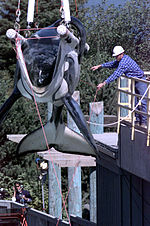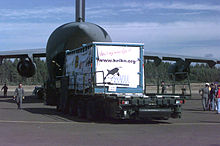Keiko (orca)
Keiko (* 1976 / 77 in Iceland ; † 12. December 2003 in the Norwegian Taknesfjord ) was an Orca -Männchen, the title role in the movie Free Willy - call of liberty of 1993 and in the two sequels Free Willy 2 - The Adventure Home ( 1995) and Free Willy 3 - The Rescue (1997) acted. The high level of awareness of the first part, in which the orca Willy frees himself from captivity by jumping into the sea, led to Keiko being released into the wild and finally released in 2002. He died in the wild after a year and a half.
Life
Keiko was caught off Iceland in 1979 and first brought to Marineland , Ontario , then sold to the Reino Aventura amusement park in Mexico City in 1985 . His imprisonment led to protests from many, especially young, viewers of the film.
Finally, with the help of donations, the Free Willy Keiko Foundation managed to buy the whale and prepare for its release in the sea. At that time, Keiko's health was very serious due to poor living conditions (water that was too warm, chlorine was too high) and vets predicted his death within the next three months. In January 1996 he was flown to the Oregon Coast Aquarium in Newport , where he was nursed and gained a ton in weight. In 1998 he was flown , also financed by donations, by the US Air Force to the Icelandic Klettsvik Fjord on the island of Heimaey , part of the Vestmannaeyjar ( Westman Islands) . In this bay it should get used to its natural habitat again and be prepared for release into the open sea.
His life in freedom was trained until 2002, when he was abandoned in the Atlantic . The action cost $ 20 million (around 16.3 million euros). There, however, the whale, which had lived among humans for years, was no longer able to adapt. Intensive human care was still necessary, the whale initially found no connection with another group of whales. Eventually the "whale training" paid off and Keiko swam with another group of killer whales. Despite observation with a satellite tracking device, Keiko's trail was lost on July 11, 2002. In September it was discovered that he had followed a fishing boat to Halsa in Norway . He was self-sufficient at this point and was in normal condition.
Keiko spent the last few weeks of his life close to people in a fjord (Taknesfjord) in Norway, where he became a tourist attraction. After pneumonia , which is not uncommon in older orca bulls in the wild, he refused to eat and died at the age of 27 on the coast near Halsa. Orca males have an average life expectancy of 40 years, only in rare cases do they live up to 50 years. Keiko was buried near the coast of Taknes Bay. A memorial was also set up in Halsa. A preparation was discussed, but not carried out. The Oregon Coast Aquarium held a memorial service for Keiko on February 20, 2004.
Environmentalists criticized the release from the start. They argued that the effort that went into releasing a single and relatively unsuitable whale was far exaggerated and would divert necessary funds from other, more important projects. The action serves more to entertain and satisfy human needs than to protect the environment or animals . On the other hand, his life has been compromised by humans and he made contact with other killer whales in the wild, at least for a time.
Web links
- "Free Willy" star Keiko: The whale that didn't want to be free , Spiegel.de, December 12, 2003
Individual evidence
- ↑ https://www.youtube.com/watch?v=p7kQYj2MgAY Minute 70, accessed on July 14, 2014
- ↑ https://www.youtube.com/watch?v=p7kQYj2MgAY
- ↑ [1]


